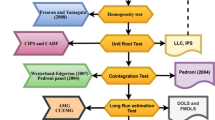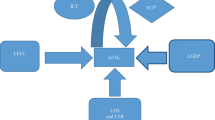Abstract
The aim of this study is to examine the impact of foreign direct investments, economic growth, and energy consumption on carbon dioxide subcomponents in the case of the USA. Dynamic ARDL (DARDL) econometric method is used covering the period 1972–2020. In addition to the total CO2 emission, the subcomponents of CO2 emission are examined separately within the framework of the EKC hypothesis in the USA by avoiding aggregation bias for the first time. The CO2 emission subcomponents used in the study are as follows; CO2 emissions from liquid fuel consumption, residential buildings, and commercial and public services; electricity and heat production; and other sectors, excluding residential buildings and commercial and public services, and CO2 emissions from transportation. Each CO2 emission component is used as a dependent variable and 6 different models were created. Foreign direct investments, trade, and energy consumption are used as control variables. No results supporting the EKC hypothesis are determined in any model, except for model 1, where total CO2 emission is the dependent variable. In addition, the trade variable has been determined as an important factor in reducing CO2 emissions in the short and long term. Trade and GDP per capita increasing and energy consumption reducing will show positive results in order to increase the environmental quality in the USA. Moreover, the study in which this EKC hypothesis is tested with CO2 emission and its subcomponents is an important study in terms of providing the opportunity to analyze the environmental quality from different angles at the same time and to take various measures together in the US economy.






Similar content being viewed by others
Data availability
Not applicable.
References
Apergis N, Christou C, Gupta R (2017) Are there environmental Kuznets curves for US state-level CO2 emissions? Renew Sustain Energy Rev 69:551–558
Apergis N, Payne JE (2009) CO2 emissions, energy usage, and output in Central America. Energy Policy 37(8):3282–3286
Aslan A, Destek MA, Okumus I (2018a) Sectoral carbon emissions and economic growth in the US: further evidence from rolling window estimation method. J Clean Prod 200:402–411
Aslan A, Destek MA, Okumus I (2018b) Bootstrap rolling window estimation approach to analysis of the environment Kuznets curve hypothesis: evidence from the USA. Environ Sci Pollut Res 25:2402–2408
Aslan A, Gozbasi O (2016) Environmental Kuznets curve hypothesis for sub-elements of the carbon emissions in China. Nat Hazards 82(2):1327–1340
Atasoy BS (2017) Testing the environmental Kuznets curve hypothesis across the U.S.: evidence from panel mean group estimators. Renew Sustain Energy Rev 77:731–747
Azam M, Khan AQ (2016) Testing the environmental Kuznets curve hypothesis: a comparative empirical study for low, lower middle, upper middle and high income countries. Renew Sustain Energy Rev 63:556–567
Azam M, Khan AQ, Abdullah HB, Qureshi ME (2016) The impact of CO2 emissions on economic growth: evidence from selected higher CO2 emissions economies. Environ Sci Pollut Res 23:6376–6389
Baek J (2015) Environmental Kuznets curve for CO2 emissions: the case of Arctic countries. Energy Econ 50:13–17
Bakirtas I, Cetin MA (2017) Revisiting the environmental Kuznets curve and pollution haven hypotheses: MIKTA sample. Environ Sci Pollut Res 24:18273–18283
Balsalobre-Lorente D, Shahbaz M, Roubaud D, Farhani S (2018) How economic growth, renewable electricity and natural resources contribute to CO2 emissions? Energy Policy 113:356–367
Bilgili F, Koçak E, Bulut Ü (2016) The dynamic impact of renewable energy consumption on CO2 emissions: a revisited environmental Kuznets curve approach. Renew Sustain Energy Rev 54:838–845
Bulut U (2019) Testing environmental Kuznets curve for the USA under a regime shift: the role of renewable energy. Environ Sci Pollut Res 26:14562–14569
Congregado E, Feria-Gallardo J, Golpe AA (2016) Jesús Iglesias, The environmental Kuznets curve and CO2 emissions in the USA is the relationship between GDP and CO2 emissions time varying? Evidence across economic sectors. Environ Sci Pollut Res 23:18407–18420
Danish K, Ulucak R (2020) Linking biomass energy and CO2 emissions in China using dynamic Autoregressive-Distributed Lag simulations. J Cleaner Prod 250:119533
Dinda S (2004) Environmental Kuznets curve hypothesis: a survey. Ecol Econ 49:431–455
Dogan E, Turkekul B (2016) CO2 emissions, real output, energy consumption, trade, urbanization and financial development: testing the EKC hypothesis for the USA. Environ Sci Pollut Res 23(2):1203–1213. https://doi.org/10.1007/s11356-015-5323-8 (Epub 2015 Sep 9)
Dogan E, Ozturk I (2017) The influence of renewable and non-renewable energy consumption and real income on CO2 emissions in the USA: evidence from structural break tests. Environ Sci Pollut Res 24:10846–10854
Farhani S, Balsalobre-Lorente D (2019) Comparing the role of coal to other energy resources in the environmental Kuznets curve of three large economies. Chin Econ. https://doi.org/10.1080/10971475.2019.1625519
Flores CA, Flores AL, Kapetanakis D (2014) Lessons from quantile panel estimation of the environmental Kuznets curve. Econ Rev 33(8):815–853
Friedl B, Getzner M (2003) Determinants of CO2 emissions in a small open economy. Ecol Econ 45(1):133–148
Galeotti M, Manera M, Lanza A (2009) On the robustness of robustness checks of the environmental Kuznets curve hypothesis. Environ Resource Econ 42:551–574. https://doi.org/10.1007/s10640-008-9224-x
Global Energy & CO2 Status Report (2018) The latest trends in energy and emissions in 2018. International Energy Agency. https://www.iea.org/geco/emissions/
Grosman G, Krueger A (1995) Environmental impacts of a North American free trade agreement. National Bureau of Economic Research 3914
Isik C, Ongan S, Özdemir D (2019a) The economic growth/development and environmental degradation: evidence from the US state-level EKC hypothesis. Environ Sci Pollut Res 26(30):30772–30781
Işık C, Ongan S, Özdemir D (2019b) Testing the EKC hypothesis for ten US states: an application of heterogeneous panel estimation method. Environ Sci Pollut Res 26:10846–10853. https://doi.org/10.1007/s11356-019-04514-6
Jalil A, Feridun M (2011) The impact of growth, energy and financial development on the environment in China: a cointegration analysis. Energy Econ 33:284–291. https://doi.org/10.1016/j.eneco.2010.10.003
Jensen V (1996) The pollution haven hypothesis and the industrial flight hypothesis: some perspectives on theory and empirics. Working Paper 1996.5, Centre for Development and the Environment, University of Oslo.
Jordan S, Philips AQ (2018) Cointegration testing and dynamic simulations of autoregressive distributed lag models. The Stata Journal: Promoting Communications on Statistics and Stata 18(4):902–923
Kais S, Sami H (2016) An econometric study of the impact of economic growth and energy use on carbon emissions: panel data evidence from fifty eight countries. Renew Sustain Energy Rev 59:1101–1110
Koondhar MA, Qıu L, Lı H, L W, He G (2018) A nexus between air pollution, energy consumption and growth of economy: A comparative study between the USA and China-based on the ARDL bound testing approach. Agric. Econ. – Czech 64(6):265–276
Kuznets S (1955) Economic growth and income inequality. Am Econ Rev 45:1–28
Lebe F (2016) The environmental Kuznets curve hypothesis: cointegration and causality analysis for Turkey. Doğuş Üniv Derg 17(2):177–194
Lieb CM (2003) The environmental Kuznets curve-a survey of the empirical evidence and of possible causes, University of Heidelberg, Discussion Paper series no 391
Menyah K, Wolde-Rufael Y (2010) CO2 emissions, nuclear energy, renewable energy and economic growth in the US. Energy Policy 38(6):2911–2915
Mercan M, Karakaya E (2015) Energy consumption, economic growth and carbon emission: dynamic panel cointegration analysis for selected OECD countries. Proc Econ Financ 23:587–592
Narayan P, Smyth R (2008) Energy consumption and real GDP in G7 countries: new evidence from panel cointegration with structural breaks. Energy Econ 30(5):2331–2341
Nasr AB, Balcilar M, Akadiri SS, Gupta R (2019) Kuznets curve for the US: a reconsideration using cosummability. Soc Indic Res 142:827–843. https://doi.org/10.1007/s11205-018-1940-1
Ozturk I (2010) A literature survey on energy–growth nexus. Energy Policy 38(1):340–349
Özokcu S, Özdemir Ö (2017) Economic growth, energy, and environmental Kuznets curve. Renew Sustain Energy Rev 72:639–647
Panayotou T (1993) Empirical tests and policy analysis of environmental degradation at different stages of economic development, working paper WP238. International Labor Office, Geneva, Switzerland
Pesaran MH, Shin Y, Smith RJ (2001) Bounds testing approaches to the analysis of level relationships. J Appl Econometr 16(3): 289–3263
Raza SA, Shah N (2018) Testing environmental Kuznets curve hypothesis in G7 countries: the role of renewable energy consumption and trade. Environ Sci Pollut Res 25(27):26965–26977
Sadorsky P (2010) The impact of financial development on energy consumption in emerging economies. Energy Policy 38(5):2528–2535
Sadorsky P (2011) Financial development and energy consumption in Central and Eastern European frontier economies. Energy Policy 39(2):999–1006
Sarkodie SA, Strezov V, Weldakidan H, Asamoah EF, Owusu PA, Doyi INY (2019) Environmnetal sustainability assessment using dynamic autoregressive-distributed lag simulations-nexus between greenhouse gas emissions, biomass energy, food and economic growth. Sci Total Environ 668:318–332
Sarkodie SA, Strezov V (2018) Empirical study of the environmental Kuznets curve and environmental sustainability curve hypothesis for Australia, China, Ghana and USA. J Clean Prod 201:98–110
Selden TM, Song D (1994) Environmental quality and development: is there a Kuznets curve for air pollution? J Environ Econ Environ Mgmt 27:147–162
Shahbaz M, Sinha A (2018) Environmental Kuznets curve for CO2 emission: a literature survey. https://mpra.ub.uni-muenchen.de/86281/ MPRA Paper No. 86281
Shahbaz M, Solarin SA, Hammoudeh S, Syed JHS (2017) Bounds testing approach to analyzing the environment Kuznets curve hypothesis with structural beaks: the role of biomass energy consumption in the United States. Energy Econ 68:548–565
Song Y, Zhang M, Zhou M (2019) Study on the decoupling relationship between CO2 emissions and economic development based on two-dimensional decoupling theory: a case between China and the United States. Ecol Ind 102:230–236
Soytas U, Sari R, Ewing BT (2007) Energy consumption, income, and carbon emissions in the United States. Ecol Econ 62(3–4):482–489
Soytas U, Sari R (2009) Energy consumption, economic growth, and carbon emissions: challenges faced by an EU candidate member. Ecol Econ 68(6):1667–1675
Stern DI (2004) Environmental Kuznets curve, Encyclopedia of Energy 2
Wang S, Yang F, Wang X, Song J (2017) A microeconomics explanation of the environmental Kuznets curve (eKc) and an empirical Investigation. Pol J Environ Stud 26(4):1757–1764
Zhang YJ, Bian XJ, Tan WP (2018a) The linkages of sectoral carbon dioxide emission caused by household consumption in China: evidence from the hypothetical extraction method. Empir Econ 54:1743–1775
Zhang YJ, Da YB (2015) The decomposition of energy-related carbon emission and its decoupling with economic growth in China. Renew Sustain Energy Rev 41:1255–1266
Zhang YJ, Jin YL, Shen B (2018b) Measuring the energy saving and CO2 emissions reduction potential under China’s belt and road initiative. Comput Econ. https://doi.org/10.1007/s10614-018-9839-0
Zhang YJ, Zhang KB (2018) The linkage of CO2 emissions for China, EU, and USA: evidence from the regional and sectoral analyses. Environ Sci Pollut Res 25:20179–20192
Ziaei SM (2015) Effects of financial development indicators on energy consumption and CO2 emission of European, East Asian and Oceania countries. Renew Sustain Energy Rev 42:752–759
Author information
Authors and Affiliations
Contributions
Writing—original draft, conceptualization: OO; writing—original draft: AA; data curation: BO; supervision, project administration: AA.
Corresponding author
Ethics declarations
Ethics approval and consent to participate
Not applicable.
Consent for publication
Not applicable.
Competing interests
The authors declare no competing interests.
Additional information
Responsible Editor: Ilhan Ozturk
Publisher's Note
Springer Nature remains neutral with regard to jurisdictional claims in published maps and institutional affiliations.
Rights and permissions
About this article
Cite this article
Aslan, A., Ocal, O. & Özsolak, B. Testing the EKC hypothesis for the USA by avoiding aggregation bias: a microstudy by subsectors. Environ Sci Pollut Res 29, 41684–41694 (2022). https://doi.org/10.1007/s11356-022-18897-6
Received:
Accepted:
Published:
Issue Date:
DOI: https://doi.org/10.1007/s11356-022-18897-6




